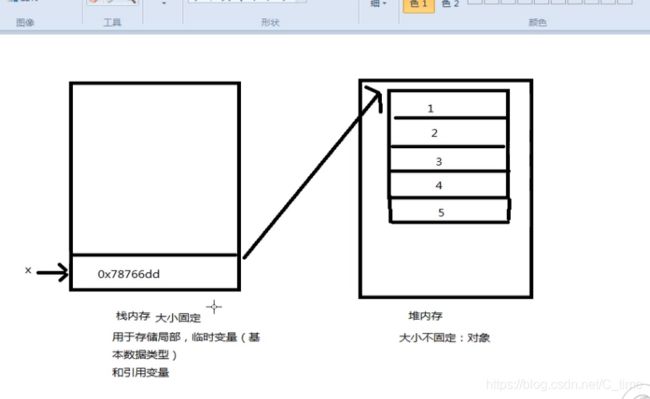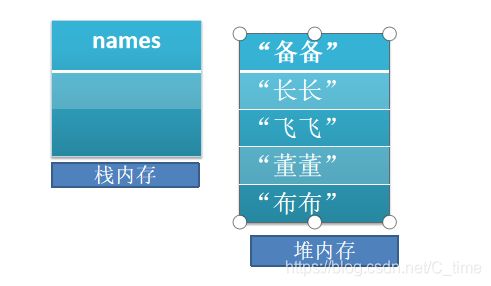Java基础之方法的重载 数组定义遍历内存分析
- 方法重载:overloading method
- 在类中可以创建多个方法,它们具有相同的名字,但具有不同的参数和不同的定义;
- 返回值 不能 作为重载的条件。 如果两个函数名字相同 参数相同 仅返回值不同 则不能同时定义
如:
public void method(int a){…}
public void method(char c){…}
/**
方法(函数)
方法的重载:在同一个类中,方法名相同,参数列表不同,返回值不能作为重载的条件。
*/
import java.util.Scanner;
public class Test5{
public static void main(String[] args){
int result = add(10,20);
System.out.println(result);
}
public static int add(int a,int b){
return a+b;
}
public static float add(float a,float b){
return a+b;
}
public static float add(int a,float b){
return a+b;
}
}
四种:
一、使用默认的初始值来初始化数组中的每一个元素加粗样式
语法:数组元素类型 [] 数组名 = new 数组元素类型[数组中元素的个数(数组的长度)];
如:int [] scores = new int[3];
二、先声明,然后再赋予默认的初始值。
语法:数组元素类型 [] 数组名;
数组名= new 数组元素类型[数组中元素的个数(数组的长度)];
如:int [] scores;
scores = new int[3];
三、先声明,然后再使用指定的值进行初始化。
语法:数组元素类型 [] 数组名 = new 数组元素类型[]{元素1,元素2,…};
如:int [] scores = new int[]{56,78,98};
四、将第三种写法可以简化为(使用数组常量值给数组进行赋值)
语法:数组元素类型 [] 数组名 = {元素1,元素2,…};
如:int [] scores = {56,78,98};****
数组的遍历
1.5以后Java新增foreach循环和可变参数。
for(int x:scores){
System.out.println(x);
}
遍历方式二:使用增强for循环【foreach循环】
语法:for(数组中元素的类型 变量:数组名){
数组中元素的类型 临时变量 = 变量;
}
结合方法的定义,可以用可变参数来代替数组作为参数。
public static void print(int … 变量名){
//可变参数在使用时作为数组使用。
}
/**
数组的遍历
*/
import java.util.Scanner;
public class Test7{
public static void main(String[] args){
int[] scores = {59,75,83,93,100};
System.out.println("数组的长度:"+scores.length);
//for遍历
int len = scores.length;/*这里不直接使用for(int i=0;i
for(int i=0;i<len;i++){ /*要int len = scores.length;将其定义出来 这样每次访问的是常量 效率提高*/
int score = scores[i];
System.out.println(score);
}
System.out.println(scores);
System.out.println("-----------------");
//forearch JDK1.5之后新增的特性
//=======================================
for(int x:scores){
System.out.println(x);
}
System.out.println("--------------");
//调用方法
//print(scores);
//print2(59,75,83,93,100); 这样就是任意多个数都可以放到print2输出 所以是可变的 没有规定个数
//print3(null);
print4(scores);
//new关键字表示创建一个数组,
int[] nums = new int[]{1,2,3,4,5};
}
public static void print(int[] x){
int len = x.length;
for(int i=0;i<len;i++){
System.out.println(x[i]);
}
}
//JDK1.5可变参数
//可变参数只能是参数列表中的最后一个 就是不能放前边print2(int... x, int k)这样不会得到k 都放到第一个参数里了,x里面了
//可变参数作为数组使用
public static void print2(int k,int... x){
int len = x.length;
for(int i=0;i<len;i++){
System.out.println(x[i]);
}
}
//测试数组的异常NullPointerException(空指针)
public static void print3(int[] x){
// java.lang.NullPointerException
//当一个变量为null(没有赋值时)时,我们去调用了该变量的属性和方法
System.out.println("数组的长度为:"+x.length);
}
//测试数组的异常,数组下标越界
// java.lang.ArrayIndexOutOfBoundsException
public static void print4(int[] x){
for(int i=0;i<=x.length;i++){
System.out.println(x[i]);
}
}
}
//测试数组的异常NullPointerException(空指针)
print3(null);
当一个变量为null(没有赋值时)时,我们去调用了该变量的属性和方法 就会发生空指针异常
测试数组的异常,数组下标越界
java.lang.ArrayIndexOutOfBoundsException
内存分析
数组内存结构分析:数组是引用类型,会存放在堆内存中。
Random r = new Random();//创建一个可以生成随机数的工具
r.nextInt(50);/获取50以内的整型随机数/
/**
数组示例:1、猜数游戏:从键盘中任意输入一个数据,判断数列中是否包含此数。
*/
import java.util.Scanner;
import java.util.Random; //生成伪随机数
public class Test8{
public static void main(String[] args){
int[] nums = new int[5];
int len = nums.length;
Random r = new Random();//创建一个可以生成随机数的工具
for(int i=0;i<len;i++){
nums[i] = r.nextInt(50);/*获取50以内的整型随机数*/
}
Scanner input = new Scanner(System.in);
System.out.println("请输入你要猜的数:(50以内)");
int userNum = input.nextInt();
boolean flag = false;
for(int x:nums){
if(userNum==x){
flag = true;
break;
}
}
if(flag){
System.out.println("恭喜你,猜对了");
}else{
System.out.println("没猜对,加油!");
}
}
}
/**
二维数组示例:JAVA中没有真正的多维数组,多维数组的表示方式是数组中的元素还是数组。
一起来参加屌丝程序员大赛吧,有3个班级各3名学员参赛,
记录每个学员的成绩,并计算每个班的平均分。
*/
import java.util.Scanner;
public class Test10{
public static void main(String[] args){
int[][] scores = {{78,98,88},{87,96,85},{67,78,89}};
int classLen = scores.length;
for(int i=0;i<classLen;i++){
int sum = 0;
int count = scores[i].length;
for(int j=0;j<count;j++){
sum+=scores[i][j];
}
int avg = sum/count;
System.out.println("第"+(i+1)+"班的平均成绩是:"+avg);
}
}
}
/*
78 98 88
87 96 85
67 78 89
*/


